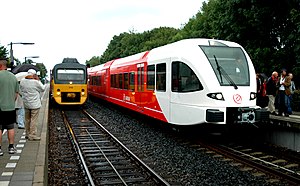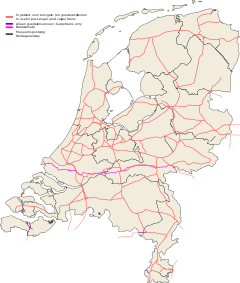Nieuweschans_railway_station
Bad Nieuweschans (Dutch pronunciation: [bɑt ˌniu.əˈsxɑns]; abbreviation: Nsch), previously named Nieuweschans (1868–2013), is an unstaffed railway station in the village of Bad Nieuweschans, Netherlands. It connects the Harlingen–Nieuweschans and Ihrhove–Nieuweschans railways and is situated between Winschoten, Netherlands and Weener, Germany.
Bad Nieuweschans | |||||||||||||||
|---|---|---|---|---|---|---|---|---|---|---|---|---|---|---|---|
 Bad Nieuweschans railway station in 2006 | |||||||||||||||
| General information | |||||||||||||||
| Location | Stationsstraat 4[1] Bad Nieuweschans, Netherlands | ||||||||||||||
| Coordinates | 53°11′03″N 7°11′58″E | ||||||||||||||
| Operated by | NS Stations | ||||||||||||||
| Line(s) | Harlingen–Nieuweschans railway Ihrhove–Nieuweschans railway | ||||||||||||||
| Platforms | 2 | ||||||||||||||
| Tracks | 2 | ||||||||||||||
| Train operators | Arriva | ||||||||||||||
| Bus operators | Qbuzz | ||||||||||||||
| Connections | Bus lines: 811, 817 | ||||||||||||||
| Other information | |||||||||||||||
| Station code | Nsch[2] | ||||||||||||||
| History | |||||||||||||||
| Opened | 1 November 1868 (1868-11-01) | ||||||||||||||
| Previous names | Nieuweschans (1868–2013) | ||||||||||||||
| Services | |||||||||||||||
| |||||||||||||||
| |||||||||||||||
The station building was completed in 1867 and demolished in 1973. Train services started on 1 November 1868. Trains were operated by Staatsspoorwegen (1868–1937), Nederlandse Spoorwegen (1938–2000), NoordNed (2000–2005), and Arriva (2006–present).
The station has two tracks and two platforms. There are two local train services with trains every hour to and from Groningen and Leer (Germany). There are also two bus connections at the station provided by Qbuzz.
The railway station is located at the Stationsstraat in the village of Bad Nieuweschans.[1] It is the easternmost station in the Netherlands[3] and connects the Dutch railway network in the west with the German railway network in the east.[4] The station is the eastern terminus of the Harlingen–Nieuweschans railway after Winschoten, which leads towards Zuidbroek and Groningen.[3] The Ulsda railway stop was between Winschoten and Nieuweschans between 1887 and 1938.[5] The station is also the western terminus of the Ihrhove–Nieuweschans railway after Weener, which leads towards Leer in Germany.[6] The distance from Bad Nieuweschans westward to railway terminus Harlingen Haven is 127 km (79 mi), to Groningen 46 km (29 mi), to Zuidbroek 25 km (16 mi), and to Winschoten 12 km (7.5 mi).[5] The distance from Bad Nieuweschans eastward to Weener is 16 km (9.9 mi) and to railway terminus Ihrhove 24 km (15 mi).[6]
The station building was completed in 1867. It was one of nine buildings in the Netherlands of the type SS Hoogezand etc. designed by Karel Hendrik van Brederode.[7] There was a customs office next to the station building.[8] The segment of the Harlingen–Nieuweschans railway between Winschoten and Nieuweschans, as it was then called, was opened on 1 November 1868.[1] The Ihrhove–Nieuweschans railway was opened on 26 November 1876.[9] Trains were operated by Maatschappij tot Exploitatie van Staatsspoorwegen until 1937.[10]
Georges Simenon's story Maigret and the Hundred Gibbets (1931) starts in this station.[11] From 1938 to 2000, trains were operated by the Nederlandse Spoorwegen, which was formed when the Maatschappij tot Exploitatie van Staatsspoorwegen and the Hollandsche IJzeren Spoorweg-Maatschappij merged.[10] In order to escape the Holocaust, Jewish physicist Lise Meitner escaped from Nazi Germany to the Netherlands, on her way to Sweden via this train station on the border.[12] During World War II, between 1942 and 1944, more than 102,000 people were transported from the Westerbork transit camp to Nazi concentration camps. Nieuweschans was the last station in the Netherlands they passed, which is commemorated with the sculpture De laatste blik (The Last View).[13] The station building was demolished in 1973.[1]
Trains service have been provided by NoordNed from 2000 to 2005,[14] and by Arriva since 2006.[15] On 15 December 2013, the village was renamed from Nieuweschans to Bad Nieuweschans and the station name was changed accordingly. In December 2015, a railway bridge near Weener was destroyed in a collision with the ship Emsmoon, and the Ihrhove–Nieuweschans railway has been closed since.[16]
The railway through Bad Nieuweschans is unelectrified and oriented west to east. At the station, the single-track railway splits into two tracks. There are two platforms, platform 1 is north of the northern track and platform 2 is south of the southern track. Beyond the station the tracks merge back into a single track.[17]
| Route | Service type | Operator | Notes |
|---|---|---|---|
| Groningen – Hoogezand-Sappemeer – Zuidbroek – Winschoten – Bad Nieuweschans – Leer (Germany) | Local ("Stoptrein") | Arriva | 1x per hour |
| Groningen – Hoogezand-Sappemeer – Zuidbroek – Winschoten (- Bad Nieuweschans) | Local ("Stoptrein") | Arriva | During morning rush hour and on evenings, a couple of runs run through to Bad Nieuweschans. |
| Line | Route | Operator | Notes |
|---|---|---|---|
| 620 | Leer – Coldam – Weener – Möhlenwarf – Bunde (- Bunderneuland – Bad Nieuweschans) | Weser-Ems Bus | Only two rush hour runs run through to Bad Nieuweschans. |
| 817 | Bad Nieuweschans – Nieuw Beerta – Drieborg – Ganzedijk – Finsterwolde | Taxi De Grooth | Only one run during both rush hours. |
- (in Dutch) Station Nieuweschans, Stationsweb. Retrieved 18 April 2015.
- (in Dutch) Peter Grutter, Lijst van Verkortingen Spoorwegen, Nederlandse Vereniging van Belangstellenden in het Spoor- en tramwegwezen, 2015. Retrieved 30 May 2016.
- (in Dutch) Spoorkaart Nederland, ProRail, 2013. Retrieved 18 April 2015.
- (in Dutch) Arjan Brondijk, "In 2016 pas sneltrein naar Leer", Het Streekblad, 2013. Retrieved 7 February 2017.
- (in Dutch) Overzicht van de spoorlijn Harlingen-Leeuwarden-Groningen-Nieuweschans, Stationsweb. Retrieved 8 February 2017.
- (in German) Die Eisenbahn in Ostfriesland – Strecken & Stationen Archived 26 October 2008 at the Wayback Machine, Westbahn.de. Retrieved 7 February 2017.
- (in Dutch) Stationsgebouwen type SS Hoogezand etc, Stationsweb. Retrieved 21 May 2016.
- (in Dutch) Stationsgebouw Nieuweschans, Stationsweb. Retrieved 21 May 2016.
- (in Dutch) Rowin Penning, "6 december 1876", Noord-Nederlands Trein & Tram Museum, 2012. Retrieved 15 December 2015.
- (in Dutch) Maatschappij tot exploitatie van staatsspoorwegen 1863–1937, Het Utrechts Archief, 2013. Retrieved 7 February 2017.
- The Hanged Man of Saint-Pholien (Inspector Maigret) Paperback – April 1, 2014, Amazon. Retrieved 7 February 2017.
- Sime, Ruth Lewin (March 1990). "Lise Meitner's escape from Germany". American Journal of Physics. 58 (3): 262–267. Bibcode:1990AmJPh..58..262S. doi:10.1119/1.16196. ISSN 0002-9505.
- (in Dutch) Bad Nieuweschans, 'De laatste blik', National Committee for 4 and 5 May. Retrieved 18 April 2015.
- (in Dutch) "NoordNed neemt spoorlijnen van NS over", Nieuwsblad van het Noorden, 2000. Retrieved 7 February 2017.
- (in Dutch) "Arriva lijft vervoerder NoordNed in", Friesch Dagblad, 2005. Retrieved 7 February 2017.
- (in Dutch) "Schip ramt spoorbrug Weener en legt treinverkeer Leer plat", Dagblad van het Noorden, 2015. Retrieved 21 May 2016.
- Leeuwarden–Groningen, Sporenplan. Retrieved 4 May 2016.
- Bad Nieuweschans station, station information
